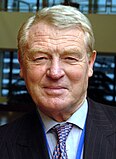| |||||||||||||||||||||||||||||||||
All 39 non-metropolitan counties, 1 sui generis authority, all 26 Northern Irish districts and all 8 Welsh counties | |||||||||||||||||||||||||||||||||
|---|---|---|---|---|---|---|---|---|---|---|---|---|---|---|---|---|---|---|---|---|---|---|---|---|---|---|---|---|---|---|---|---|---|
| |||||||||||||||||||||||||||||||||
 Colours denote the winning party, as shown in the main table of results. | |||||||||||||||||||||||||||||||||
The 1993 United Kingdom local elections were held on Thursday 6 May 1993 in England and Wales, and Wednesday 19 May 1993 in Northern Ireland.[1][2] The results showed a decline for the governing Conservative Party, who were still reeling from the fallout of Black Wednesday; with the third-placed party, the Liberal Democrats, gaining most seats.
The main opposition Labour Party, now led by John Smith following Neil Kinnock's resignation as party leader, gained 111 seats, bringing their number of councillors to 9,213. Their share of the vote was projected to be 39%, their highest since 1990.
The governing Conservative Party lost 486 seats and was left with 7,802 councillors. Their projected share of the vote was 31%, a 15% decline since the previous local elections in 1992.
The Liberal Democrats gained 395 seats and had 4,123 councillors after the elections. Their projected share of the vote was 25%, an increase in 5% from the 1992 local elections.
On the same day as local elections in England and Wales, a parliamentary by-election was held in the Newbury constituency in Berkshire. The Conservatives lost this seat to the Liberal Democrats.
- ^ Rallings, Colin; Thrasher, Michael. Local Elections Handbook 1993 (PDF). Local Government Chronicle Elections Centre. Retrieved 3 May 2016.
- ^ "Council compositions". The Elections Centre. Retrieved 3 May 2016.

